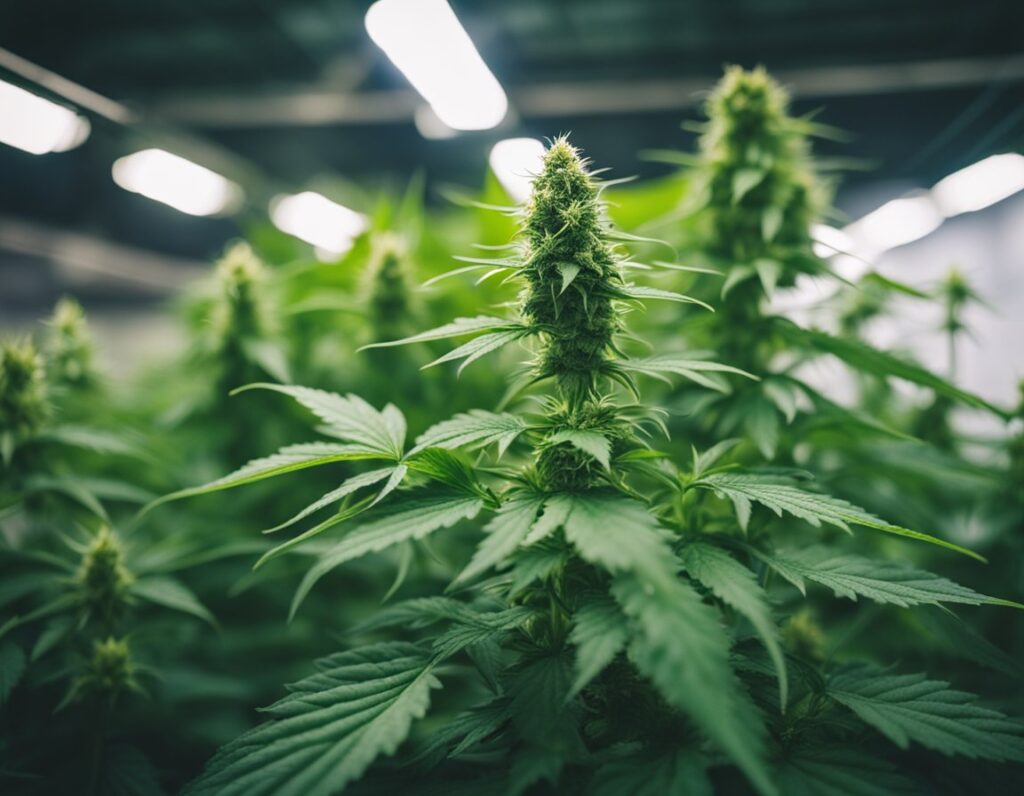
Effective pest management is crucial for maintaining the health and yield of your cannabis plants. Whether you are growing Marijuana Seeds Vancouver enthusiasts seek or established strains, utilizing integrated pest management (IPM) and biological controls can significantly reduce pest issues while promoting a healthier crop environment.
Integrated Pest Management (IPM) is a holistic approach that focuses on understanding pest life cycles and their interactions with cannabis plants. This method involves several key steps:
IPM emphasizes reducing reliance on pesticides, therefore promoting a balanced ecosystem within your growing environment.
Biological controls play a vital role in IPM by utilizing natural predators and beneficial organisms to manage pest populations. Common strategies include:
Combining these methods with regular monitoring allows you to maintain healthy plants while minimizing chemical inputs. Focus on creating an ecosystem that supports beneficial organisms to enhance your pest management efforts.

Maintaining the health of your cannabis plants in Vancouver requires diligent preventive strategies. Protecting plants pests Vancouver growers often face involves regular monitoring and using physical barriers to reduce the risk of pest infestations and protect your plants effectively.
Regular monitoring of your plants is crucial for early detection of pests. Inspect your cannabis plants at least once a week, focusing on the underside of leaves and the base of stems. Look for signs of pest activity, such as webbing, discoloration, or small holes in leaves.
Consider using sticky traps to catch flying insects and monitor their populations. Keep a record of your findings to identify any trends in pest activity. This data can guide your treatment strategies and timing.
Using beneficial insects, such as ladybugs and predatory mites, can also provide natural pest control while you monitor. These insects help keep pest populations in check, complementing your monitoring efforts.
Organic mulch is an effective strategy for preventing pest access to your cannabis plants. Applying a layer of mulch around the base of your plants can deter pests such as slugs and soil-borne insects. It also helps retain moisture and improve soil health.
In addition to mulch, consider installing physical barriers like row covers or mesh nets. These can protect your plants from larger pests while allowing sunlight and moisture to reach them. Make sure to secure the edges to prevent small pests from sneaking underneath.
Combining these methods with regular soil inspections will create a less hospitable environment for pests. This proactive approach is essential in maintaining the vitality of your cannabis garden.
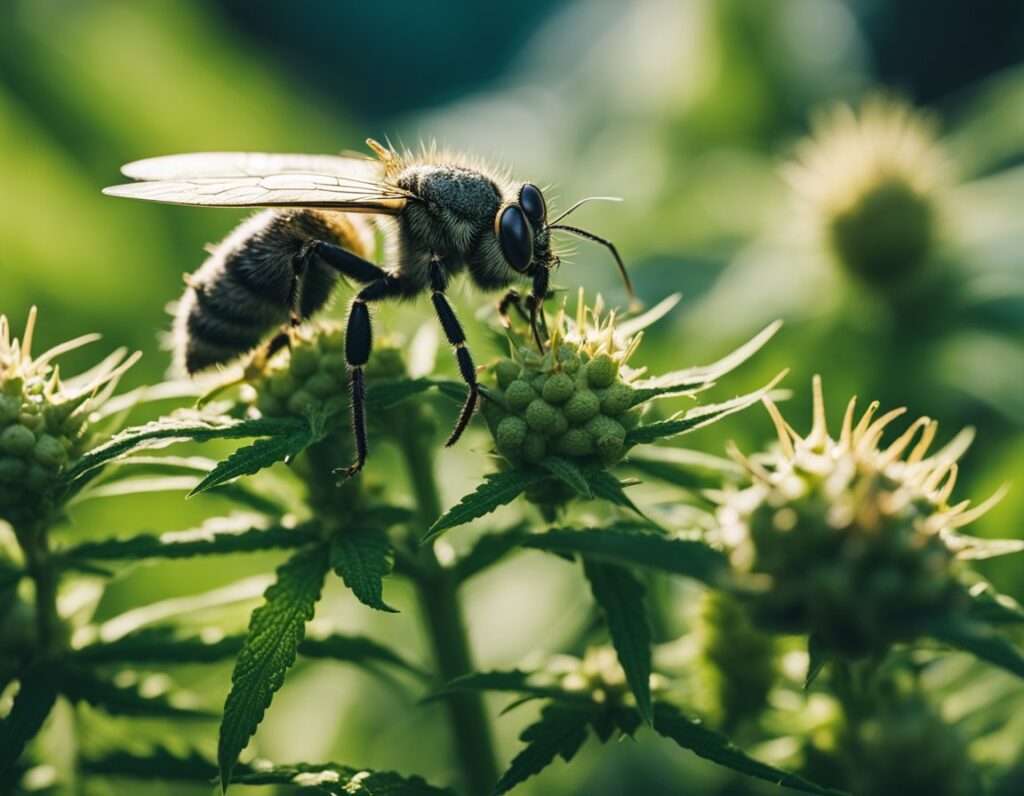
Recognizing pests in your cannabis crop is crucial for maintaining plant health and maximizing yields. This section highlights the key symptoms you should watch for and outlines quarantine procedures to protect your plants.
Identifying pests early can prevent significant damage to your cannabis plants. Common pests such as aphids, root aphids, spider mites, and thrips display various symptoms:
Regularly inspecting your plants can help you catch these symptoms early.
To prevent introducing pests into your existing cannabis crops, implement strict quarantine procedures for any new plants. Follow these steps:
By adhering to quarantine measures, you can significantly reduce the risk of pest infestations in your cannabis garden.
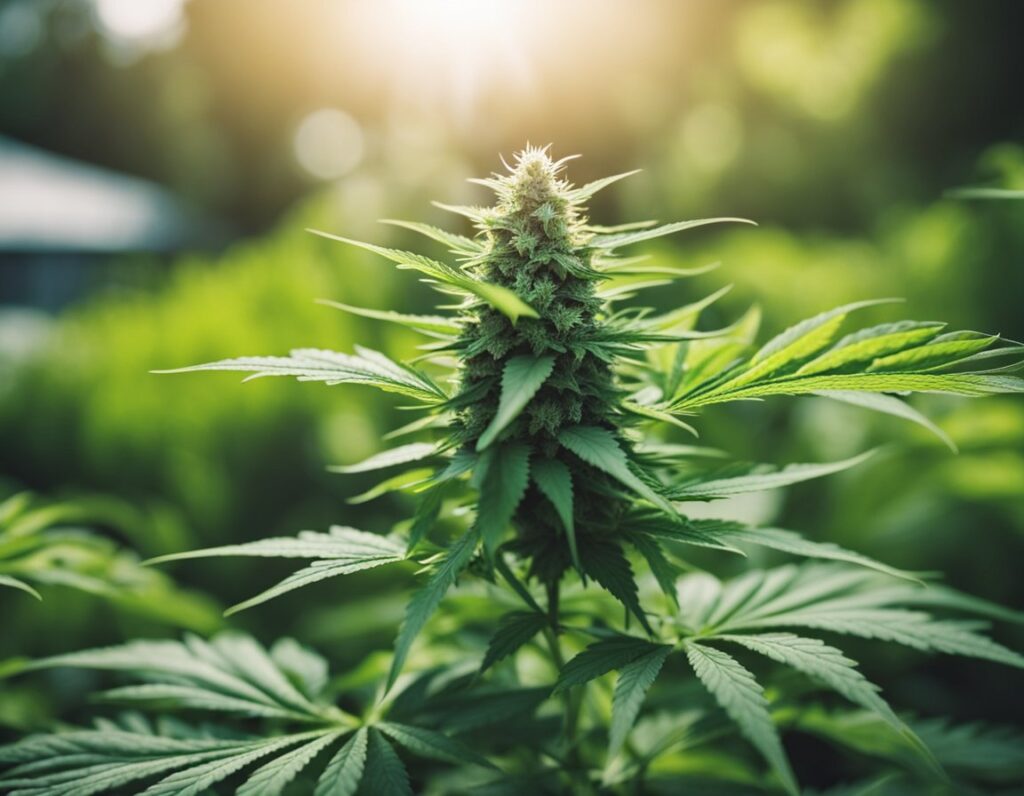
Managing pests in cannabis cultivation can be effectively achieved using a combination of natural and chemical control methods. Understanding these options enables you to maintain healthy plants while minimizing pest impact.
Horticultural oils and insecticidal soaps are effective natural solutions. These products suffocate pests by blocking their breathing pores.
Example Options:
Using these treatments is most effective when applied early in the season. Application Tips:
Incorporating beneficial predators, such as ladybugs, can also help manage pest populations naturally. This holistic approach minimizes pesticide dependency.
When natural options are insufficient, chemical pesticides may be necessary. These products are designed to target specific pests effectively.
Key Factors to Consider:
Types of Chemical Pesticides:
Monitor your plants regularly after treatment to assess effectiveness and avoid resistance build-up among pest populations. Always maintain safe handling and application practices to protect yourself and the environment.
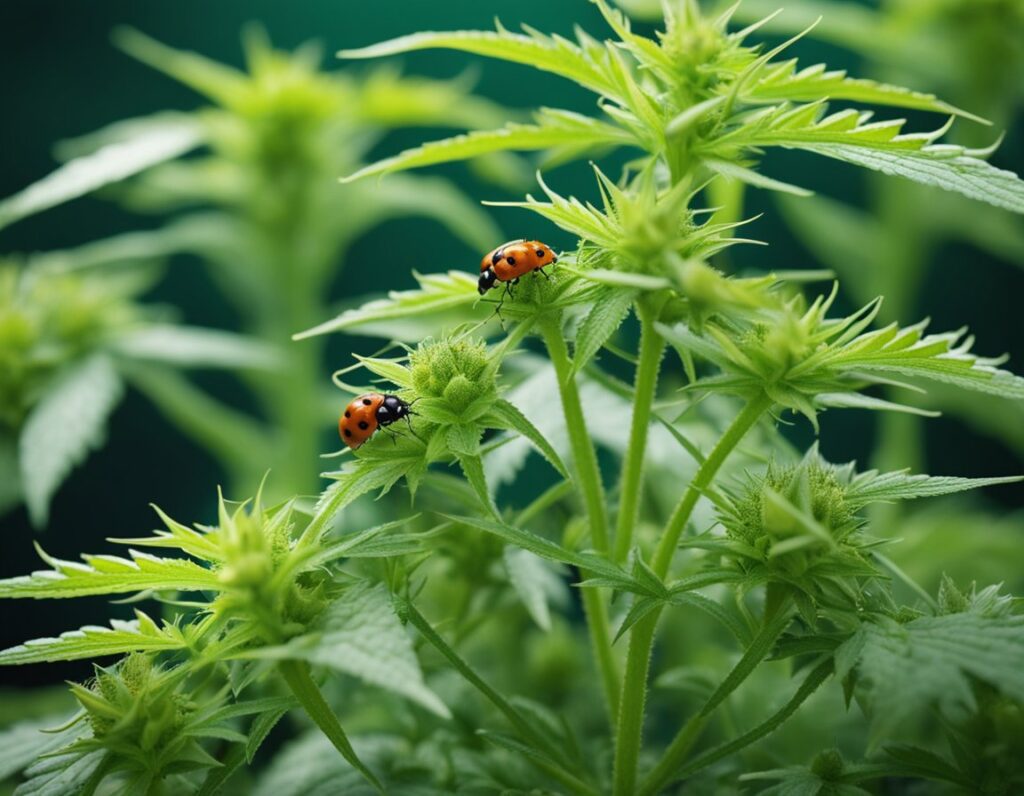
Utilizing beneficial organisms is a key strategy for protecting cannabis plants from pests. These organisms can contribute to pest management by either preying on harmful pests or improving soil health, leading to stronger plants. Two effective methods include introducing predatory mites and nematodes, alongside soil drench applications.
Predatory mites, such as Phytoseiulus persimilis, can effectively control spider mite populations. These mites feed on eggs, nymphs, and adult stages of harmful pests, significantly reducing their numbers. For optimal success, release predatory mites early in the pest life cycle.
Beneficial nematodes, like Steinernema and Heterorhabditis species, target soil-dwelling pests. They enter the pest’s body and release bacteria, which ultimately leads to its death. These nematodes are particularly useful against root pests like fungus gnats and thrips. Proper application techniques and timing are essential for effectiveness.
Soil drench applications involve applying beneficial microorganisms directly to the soil. This method can enhance plant health and resilience against pests. Certain microbial mixes can suppress pathogens and promote a healthy rhizosphere.
Using a tailored soil drench formulation can improve nutrient uptake and bolster the plant’s natural defenses. Microorganisms such as Bacillus subtilis can thrive in the root zone, helping plants recover from stress and resist pest attacks. Regular applications, timed with the growth cycle, are crucial to maintain effectiveness.
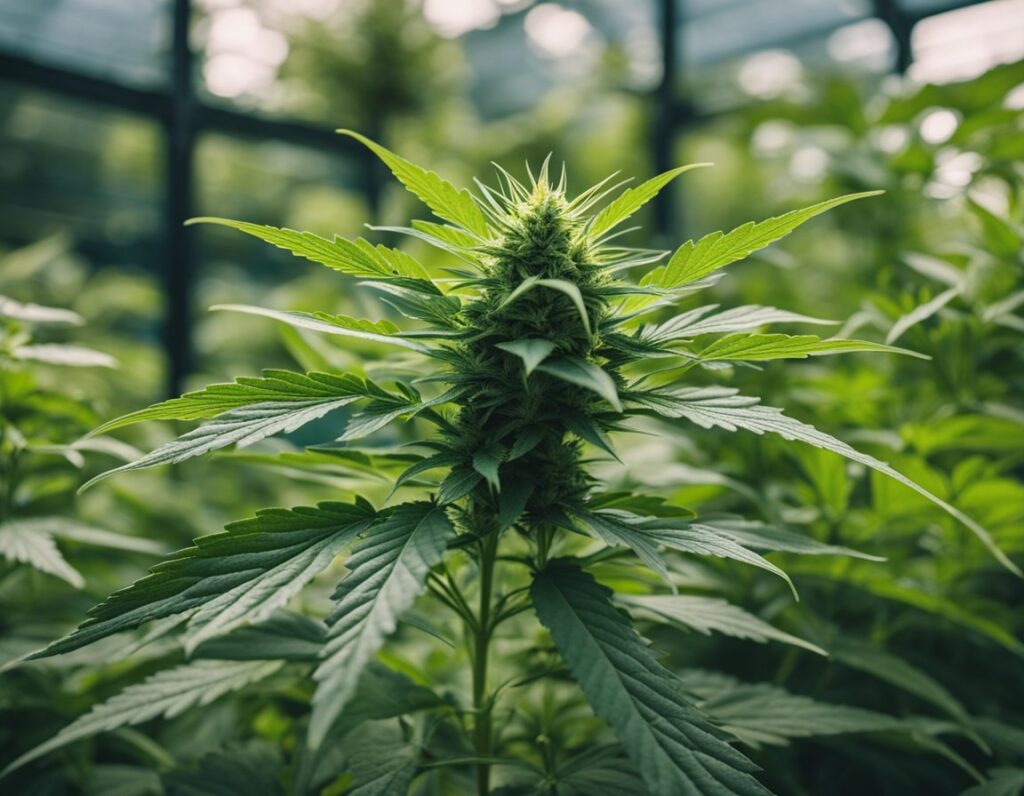
Maintaining the health of your cannabis plants requires vigilance in identifying nutrient deficiencies, diseases, and pest infestations. Recognizing these issues early can enhance your plants’ resilience and improve yields.
Nutrient deficiencies can manifest in various ways. Yellowing leaves might indicate a nitrogen deficiency, while stunted growth can point to a lack of phosphorus. Symptoms like wilting leaves often arise from dehydration or root issues.
Diseases such as powdery mildew present as white, powdery spots on leaves and can severely impact plant health. It’s crucial to monitor your plants regularly, looking for any changes in foliage or growth patterns. A well-balanced nutrient solution tailored to the specific needs of cannabis can prevent many deficiencies and promote robust growth.
Root aphids are small pests that can significantly harm cannabis plants by feeding on the roots. Signs of root aphid infestation include wilting despite adequate watering and the presence of a sticky residue on the soil.
To treat this problem, you can use organic insecticides specifically formulated for root pests. Alternatively, introducing beneficial nematodes into the soil can help naturally control their populations. Regular monitoring and maintaining healthy soil conditions can also prevent infestations, ensuring your cannabis plants thrive.
Understanding how to protect your cannabis plants from pests is crucial for successful cultivation. Below are answers to common questions that can help you manage pests effectively and sustainably.
You can spot common pests like aphids, spider mites, and whiteflies by observing the leaves and stems of your plants. Look for discolored leaves, webbing, or small insects. Regular inspections will help you catch infestations early.
In humid climates, maintain proper air circulation and humidity levels to deter pests. Implement preventive measures like crop rotation and using companion plants. Beneficial insects like ladybugs can also help control pest populations naturally.
Choose products labeled for cannabis use that contain ingredients like neem oil, insecticidal soap, or diatomaceous earth. Always read the label for application guidelines and adhere to safety recommendations to protect your plants and health.
Natural remedies include using neem oil, garlic spray, or essential oils such as peppermint. Introduce beneficial insects like predatory mites to control pest populations without chemical intervention. Always test any solution on a small plant area first.
In Canada, pesticides used on cannabis must be registered under the Pest Control Products Act. Ensure that any product you use is compliant with local regulations. It’s essential to keep records of applications as well.
We ship and deliver world wide via USPS and various couriers.
We offer a wide range of secure and anonymous online payment options.
We care about you, our customer. Please contact us with any questions or concerns.
Find out more about the benefits of being a loyal and regular customer.
WE ARE EVERY GROWERS ONE STOP SHOP TO ACQUIRE PREMIUM CANNABIS SEEDS FOR SALE IN THE USA, CANADA AND AUSTRALIA

Farmers Lab Seeds 2024, | All Right Reserved
Seeds are sold as novelty items, souvenirs, and collectibles. They contain 0% THC. We encourage our customers to check the legislation in their Country, State, Province, and Municipality prior to purchasing items from our store. We do not provide growing information.
All seeds are sold as hemp, and lab tested under 0.3% THC. This product is not for use by or sale to persons under the age of 21. This product should be used only as directed on the label. It should not be used if you are pregnant or nursing. Consult with a physician before use if you have a serious medical condition or use prescription medications. A Doctor’s advice should be sought before using this and any supplemental dietary product. All trademarks and copyrights are property of their respective owners and are not affiliated with nor do they endorse this product.
These statements have not been evaluated by the FDA. This product is not intended to diagnose, treat, cure or prevent any disease. Individual weight loss results will vary. By using this site, you agree to follow the Privacy Policy and all Terms & Conditions printed on this site. Void Where Prohibited by Law.